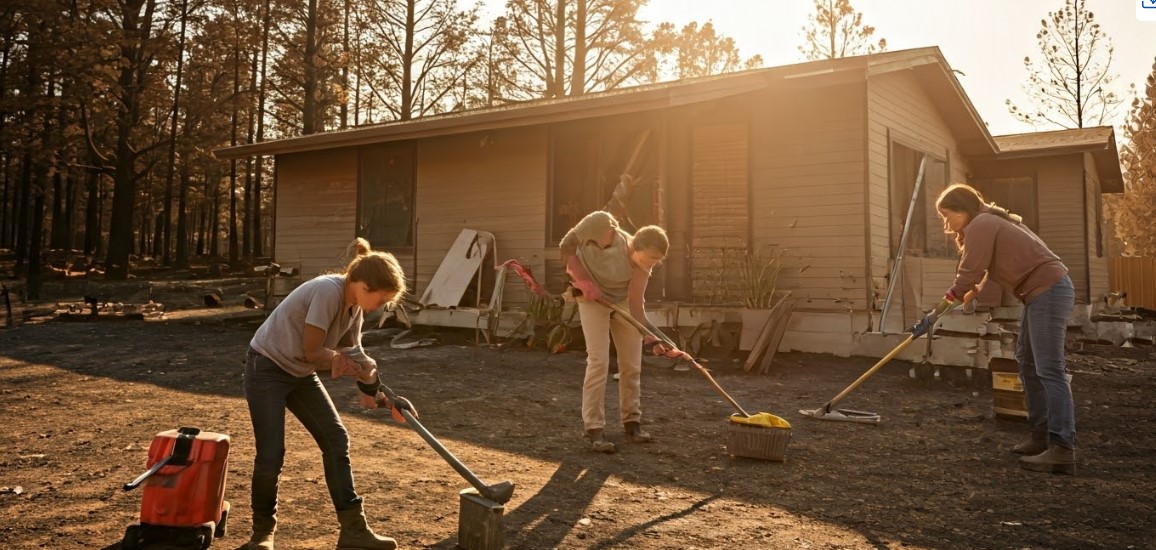Moving out of a place is a big job. It gets harder after a wildfire. Cleaning up needs careful planning. You want to make sure the space is safe and livable. This helpful checklist gives you steps to follow. It covers everything from debris removal to the final paperwork for insurance.
Your Comprehensive Move-Out Cleaning Checklist Following Wildfire Damage
This checklist helps make the move-out cleaning easier by breaking it down into simple parts. Each part focuses on different areas that suffered from wildfire damage. This gives you a clear plan for effective cleanup. By following these steps, you can clean thoroughly while keeping safety first and following all important rules.
1. Debris and ash removal from exterior surfaces
Exterior surfaces take the hardest hit from a wildfire. Start by cleaning up large pieces of debris. This includes fallen branches and broken fixtures. Doing this gets the area ready for a deeper cleaning.
Next, remove the ash. It is important to wear a mask while doing this. Wildfire ash can have dangerous particles in it. You can use a stiff broom and dustpan for dry ash or a pressure washer for tougher areas.
- Remember: Don’t spray surfaces directly with a hose. This can spread the ash and make it harder to clean.
- Pro Tip: Start from the top and work your way down. This will help keep cleaned areas from getting dirty again.
- Safety: Watch out for dangers like weak structures and loose power lines.
2. Cleaning and disinfecting interior surfaces
Moving inside, the attention goes to cleaning and disinfecting every surface. Soot and smoke can get into every little corner, so it is very important to be thorough.
Start by vacuuming all surfaces, like walls, ceilings, and floors. This will help remove any loose debris. After that, clean all surfaces with a strong cleaner. A mix of warm water, detergent, and vinegar is good for cutting through grease and grime.
- Key Point: Focus on high-touch areas such as doorknobs, light switches, and countertops.
- Hygiene: Always wear gloves when using cleaning solutions, and make sure there is good ventilation.
3. Checking for water damage and mold growth
Wildfire damage is not just about fire. Water damage from firefighting or leaking pipes is also a big problem. It’s important to check all areas, especially ceilings and walls, for signs of water issues like stains or bending.
Mold often grows when water damage happens. If you find mold, you need to take care of it right away. You can clean small areas with a bleach solution. However, for larger mold problems, it’s best to hire a professional for help.
- Important: Any building materials that can soak up water, like drywall or insulation, should be replaced. This will help stop mold from coming back.
4. Replacing damaged or contaminated items
Assessing the damage to your things is very important to get your living space back. If anything is damaged too much to repair or is too dirty to clean, it should be thrown away. This includes furniture with bad smoke damage, wet fabrics, and food that has been around smoke or soot.
Make a detailed list of all the damaged and thrown-away items. Take pictures and write down any important details like brand names and model numbers. This will help you when you file insurance claims. Good documentation will make it easier to get your money back.
- Important: Do not try to save heavily contaminated items. It is better to replace them for your safety and health.
5. Proper disposal of hazardous materials
Wildfires can release hazardous materials into the environment. These materials require careful handling and disposal to prevent further contamination and health risks. Never mix hazardous waste with regular trash.
Here is a guide to help categorize and dispose of hazardous waste:
| Material | Disposal Method |
| Paints, solvents, aerosols | Contact your local waste management facility for instructions |
| Batteries | Designated battery recycling centers or retailers offering battery take-back programs |
| Electronics (e-waste) | Certified e-waste recyclers or designated collection events |
| Cleaning chemicals | Check product labels for disposal instructions or contact your local waste management facility. |
- Remember: If unsure about the proper disposal method for any material, contact your local waste management facility for guidance.
6. Ventilation and air quality control measures
Even after cleaning, smoke odor may still linger in your home. Good ventilation is important to make the air better. Open windows and doors to let fresh air in. If you can, set up fans to help the air flow out.
You might also want to use air purifiers with HEPA filters. These can remove tiny smoke particles and improve the air indoors. Make sure to change the filters often, as the company advises. Another tip is to place bowls of activated charcoal around your home. This can help soak up any leftover smells.
- Pro Tip: Boiling water with cinnamon sticks or citrus peels on the stove can naturally help reduce smoke odors.
7. Final inspection and documentation for insurance purposes
After you finish cleaning, do a final check of the property. This is your chance to make sure every spot is cleaned and that there are no damages missed. Focus on the details and write everything down carefully.
Take photos and videos of the cleaned property. This helps you with your insurance claims. Keep all receipts for cleaning supplies, equipment rentals, and professional services. This paperwork proves the damage and costs from the cleanup.
- Important: Contact your insurance company to set up a visit from an adjuster. They will look at the property and help you complete your claim.
Contact Us at Fresh Flare for Professional Service
Dealing with what happens after a wildfire is hard. If it feels too much to handle, you should get professional help. Fresh Flare is here for you. We focus on cleaning up after wildfires and can return your property to a safe place to live. Our team knows how to manage all parts of wildfire damage. This includes debris removal, cleaning, mold cleanup, and getting rid of bad smells. We understand how this process affects people both emotionally and physically. We want to ease your stress. Let us handle the cleanup so you can work on getting your life back in order.
Conclusion
After a wildfire, it is very important to clean up for safety and to help restore the area. Follow these move-out cleaning checklist after a wildfire in this blog to ensure your property is properly cleaned and documented. Remember to conduct a final inspection, take photos, keep receipts, and contact your insurance company. Consider seeking professional help from Fresh Flare for a thorough cleanup process tailored to wildfire damage. By following these steps, you can navigate the aftermath of a wildfire more effectively and work towards rebuilding your life. For more tips, visit our blog about The Importance of Ash and Soot Removal for Your Health.
Frequently Asked Questions
What are the first steps in cleaning a rental property after wildfire exposure?
- First, make sure the property is in good shape.
- Next, focus on safety by putting on protective gear before you clear away debris and ash.
- After that, reach out to your landlord and insurance company.
- This will help you document the damage and talk about what to do next.
How can I ensure my safety while cleaning up ash and soot?
To protect yourself, you need to wear the right gear. This means using a mask, gloves, and long clothes. These items help reduce contact with harmful particles. Make sure there is good airflow in your space, and remember to drink water while you are working on the cleanup process.
Are there specific cleaning solutions recommended for wildfire residue?
It’s best to get product advice from experts who know about wildfire residue. You can clean soot and debris with a mix of warm water, detergent, and vinegar. Remember to try the cleaning solution in a hidden spot first.





